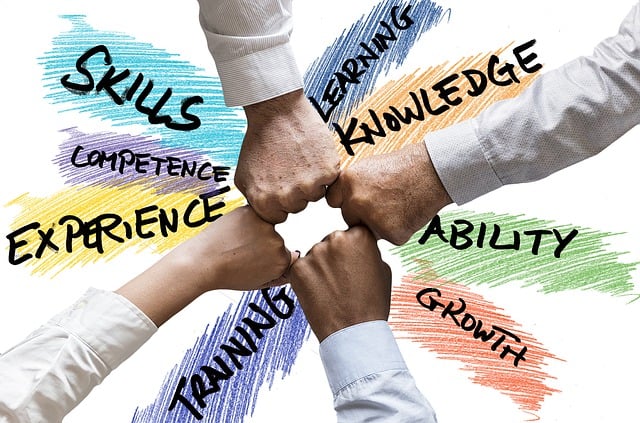
In today's fast-paced and interconnected business environment, fostering team learning is a crucial component of success. This article explores the top 10 winning strategies for creating a culture of continuous learning within teams.
From team-building exercises to collaborative problem-solving and cross-functional learning, these insights offer practical ways to enhance team dynamics and drive productivity.
By implementing these strategies, organizations can empower their teams to thrive in an ever-evolving workplace, fostering a sense of freedom and growth.
Team-Building Exercises
Utilizing team-building exercises is essential for cultivating a collaborative and cohesive work environment that promotes effective team learning. These activities play a crucial role in breaking down barriers among team members, fostering open communication, and building trust.
Team building activities can range from simple icebreaker games to more complex problem-solving challenges. Icebreaker games, for instance, are a great way to introduce team members to one another, encouraging them to interact and form connections. These games help create a relaxed and friendly atmosphere where individuals can feel comfortable sharing ideas and opinions.
On the other hand, more complex team building activities, such as problem-solving challenges, encourage collaboration and critical thinking skills. They require team members to work together to solve a problem or complete a task, promoting effective communication and cooperation.
Collaborative Problem-Solving
Collaborative problem-solving is an essential aspect of effective team learning.

To foster this, it is crucial to employ effective communication techniques that encourage open and honest dialogue among team members.
Additionally, creating an environment that values diverse perspectives can lead to innovative solutions and a deeper understanding of complex problems.
Effective Communication Techniques
One key strategy for fostering team learning is employing effective communication techniques in order to facilitate collaborative problem-solving.
Active listening is a crucial aspect of effective communication within a team. It involves giving full attention to what others are saying without interrupting or forming judgments. By actively listening, team members can better understand each other's perspectives, identify common ground, and find solutions to problems collectively.
Nonverbal communication is another important aspect of effective communication. It includes gestures, facial expressions, and body language, which can convey meaning and emotions without using words. By being aware of and using nonverbal cues effectively, team members can enhance their understanding of each other's feelings and intentions, leading to improved collaboration and problem-solving.
These communication techniques promote an open and inclusive environment, where team members feel heard and valued, ultimately enabling effective team learning.
Encouraging Diverse Perspectives
To foster team learning and promote effective problem-solving, it is essential to encourage diverse perspectives within the group. Embracing diversity and inclusion enables teams to leverage different backgrounds, experiences, and expertise to tackle complex challenges.

By valuing and actively seeking out diverse perspectives, teams can tap into a wide range of ideas, insights, and solutions that may otherwise go unnoticed. Open-mindedness is key in creating an environment where individuals feel comfortable expressing their unique viewpoints and challenging conventional thinking.
This perspective diversity not only enhances creativity and innovation but also encourages critical thinking and more robust decision-making processes. It is important to create a safe space for team members to share their perspectives without fear of judgment, allowing for open and respectful dialogue.
Shared Note-Taking
Implementing a system of shared note-taking enhances team learning and promotes effective collaboration.
When team members actively listen and take notes during meetings or discussions, they are able to capture important information and insights.
By sharing these notes with the rest of the team, everyone has access to the same information, fostering a sense of transparency and openness.
Shared note-taking also encourages information sharing among team members, as they can add their own thoughts and perspectives to the notes.
This promotes a collaborative learning environment, where everyone's input is valued and considered.

Additionally, shared note-taking serves as a valuable reference tool, allowing team members to revisit discussions and decisions made in the past.
Joint Presentations
Continuing from the discussion on shared note-taking, an effective strategy for fostering team learning is through joint presentations.
Joint presentations involve collaboration among team members to research and present a topic collectively. This approach encourages cooperative learning, where team members actively participate and contribute their unique perspectives and knowledge to the presentation.
By engaging in joint research and preparing a shared presentation, team members can deepen their understanding of the subject matter and enhance their critical thinking skills.
Furthermore, joint presentations provide an opportunity for individuals to learn from one another's strengths and expertise, promoting a sense of mutual respect and growth within the team.
This strategy not only facilitates the acquisition of knowledge but also fosters effective communication and teamwork, enabling team members to develop valuable skills that can be applied in various contexts.
Group Brainstorming
Group brainstorming is an effective technique for fostering team learning. It allows team members to collaborate and generate innovative ideas by leveraging group dynamics and creative thinking. Here are four key strategies to maximize the effectiveness of group brainstorming:

- Encourage active participation: Create a safe and inclusive environment where all team members feel comfortable sharing their ideas and opinions. Encourage everyone to actively contribute and build upon each other's thoughts.
- Embrace diversity: Recognize that diverse perspectives can lead to more creative solutions. Encourage team members with different backgrounds, expertise, and experiences to participate in the brainstorming process.
- Set clear goals: Clearly define the problem or challenge that the team is trying to solve. Establish specific goals and objectives for the brainstorming session to ensure that the discussions stay focused and productive.
- Foster a non-judgmental atmosphere: Encourage team members to suspend judgment during the brainstorming process. Emphasize that all ideas are valuable and that criticism should be deferred until after the brainstorming session.
Mutual Feedback Sessions
The article discusses the importance of incorporating mutual feedback sessions as a crucial strategy for fostering team learning.
Team reflection and constructive criticism play a significant role in enhancing the overall performance and productivity of a team.
By providing a platform for team members to share their thoughts, ideas, and concerns, mutual feedback sessions create an environment of open communication and trust.
These sessions allow team members to reflect on their individual and collective performance, identify areas for improvement, and develop action plans to address any gaps or challenges.
Constructive criticism, when delivered in a respectful and supportive manner, helps team members to understand their strengths and weaknesses, learn from their mistakes, and grow both professionally and personally.
Mutual feedback sessions promote a culture of continuous learning and improvement, fostering a sense of ownership and accountability within the team.
Common Goal Setting
One essential aspect for fostering team learning is establishing common goals that align with the team's objectives and promote collaboration and synergy among team members.

When team members are clear on their common goals, it enhances goal alignment and ensures that everyone is working towards the same purpose. This, in turn, leads to greater team cohesion and a shared sense of direction.
To effectively set common goals, teams can:
- Conduct goal-setting sessions where team members can actively participate and contribute their ideas.
- Ensure that the goals are specific, measurable, achievable, relevant, and time-bound (SMART).
- Regularly review and revise the goals to adapt to changing circumstances and priorities.
- Communicate the goals clearly to all team members, ensuring everyone understands their role in achieving them.
Cross-Functional Learning
To promote cross-functional learning, teams should encourage the exchange of knowledge and skills among members from different disciplines or departments.
Cross-functional collaboration allows individuals with diverse expertise to come together and leverage their unique perspectives to solve complex problems. By fostering interdisciplinary learning, teams can tap into a wealth of ideas and approaches that may not have been considered otherwise.
This type of collaboration leads to increased innovation and creativity within the team, as individuals learn from one another and apply their newfound knowledge to their work.
Moreover, cross-functional learning promotes a culture of continuous learning and growth, as team members are exposed to different ways of thinking and problem-solving.
Role Swapping
By implementing role swapping, teams can enhance their members' understanding of different functions and departments, leading to increased collaboration and improved problem-solving skills. Role playing allows team members to step into the shoes of their colleagues and experience their roles firsthand. This not only fosters empathy and understanding but also promotes knowledge exchange within the team.

Here are four benefits of role swapping:
- Increased empathy: Role swapping helps team members gain a deeper appreciation for the challenges and responsibilities faced by their colleagues in different roles.
- Enhanced collaboration: When team members have a better understanding of each other's roles, they can work together more effectively, leveraging each other's strengths and expertise.
- Improved problem-solving skills: Experiencing different roles can broaden team members' perspectives, enabling them to approach problems from different angles and find more innovative solutions.
- Cross-functional learning: Role swapping facilitates knowledge exchange between different functions and departments, breaking down silos and fostering a culture of continuous learning.
Shared Research Projects
Shared research projects offer numerous benefits for fostering team learning. Collaboration allows team members to pool their knowledge and skills, leading to a more comprehensive and robust outcome.
Effective project management ensures that tasks are assigned and completed efficiently, maximizing productivity and minimizing delays.
Additionally, shared research projects encourage critical thinking as team members analyze and evaluate different perspectives, leading to deeper insights and innovative solutions.
Benefits of Collaboration
Collaborating on research projects offers numerous benefits, including enhanced efficiency, increased knowledge exchange, and improved problem-solving abilities among team members.
When individuals come together to work on a shared research project, they can pool their expertise and resources, resulting in a more efficient and effective process. This collaboration also fosters knowledge sharing, as team members can learn from each other's experiences and perspectives.
Additionally, working in a team setting enhances creativity, as different ideas and approaches are brought to the table. The collective intelligence of the team can lead to innovative solutions and fresh insights that may not have been possible through individual efforts alone.

Furthermore, collaboration promotes effective problem-solving, as team members can brainstorm ideas, challenge assumptions, and provide critical feedback to each other.
Effective Project Management
When individuals come together to collaborate on shared research projects, effective project management becomes crucial for ensuring the success and productivity of the team.
Project planning is an essential aspect of effective project management, as it involves defining project goals, determining the tasks required to achieve those goals, and establishing a timeline for completion. By having a clear plan in place, team members can stay focused and work towards a common objective.
Resource allocation is another important component of effective project management. It involves identifying the resources needed for the project, such as human resources, technology, and funding, and allocating them appropriately to ensure that the project can be executed successfully.
Effective project management also involves monitoring progress, addressing any issues or obstacles that arise, and making necessary adjustments to keep the project on track.
Enhancing Critical Thinking
Effective critical thinking is essential for fostering team learning in shared research projects. By employing various critical thinking techniques and engaging in critical thinking exercises, teams can enhance their problem-solving abilities and make more informed decisions.
Here are four strategies to enhance critical thinking in shared research projects:

- Encourage diverse perspectives: By actively seeking out different viewpoints and opinions, teams can challenge their own assumptions and broaden their understanding of the research topic.
- Promote open and respectful discussions: Creating a safe space for team members to express their ideas and engage in constructive debates fosters critical thinking. It allows for the exploration of different angles and encourages creative problem-solving.
- Develop effective questioning techniques: Encouraging team members to ask thought-provoking questions promotes critical thinking. This helps to uncover underlying assumptions, evaluate evidence, and identify potential biases.
- Provide opportunities for reflection and self-assessment: Regularly reflecting on their own thinking processes and evaluating their strengths and weaknesses can help team members develop their critical thinking skills. Incorporating self-assessment exercises allows individuals to identify areas for improvement and work towards enhancing their critical thinking abilities.
Frequently Asked Questions
How Can Team-Building Exercises Contribute to Fostering Team Learning?
Team building activities and icebreaker games can contribute to fostering team learning by promoting communication, building trust, and enhancing collaboration among team members. These activities create a positive and inclusive environment that encourages learning and growth within the team.
What Are Some Effective Ways to Encourage Collaborative Problem-Solving Within a Team?
Collaborative problem-solving techniques, such as brainstorming and group discussions, are effective ways to encourage teamwork and foster innovative solutions within a team. These techniques offer the benefits of diverse perspectives, increased creativity, and shared ownership of outcomes.
Shared note-taking is a valuable strategy for promoting team learning. By encouraging collaboration and knowledge sharing, it enhances communication and fosters a sense of collective ownership. Effective implementation involves establishing clear guidelines and utilizing digital tools for seamless collaboration.
How Can Joint Presentations Enhance Team Learning and What Are Some Key Tips for Conducting Successful Presentations as a Team?
Joint presentations can greatly enhance team learning by encouraging collaboration, knowledge sharing, and skill development. To conduct successful presentations as a team, it is crucial to establish clear roles, communicate effectively, rehearse thoroughly, and engage the audience.
What Are Some Techniques to Ensure Productive Group Brainstorming Sessions That Contribute to Team Learning?
Group facilitation is essential for productive group brainstorming sessions that contribute to team learning. Techniques such as creating a safe and inclusive environment, encouraging creative thinking, and using effective facilitation tools can enhance the brainstorming process and foster collaborative learning.
 Family Craft ProjectsHome ImprovementCooking and BakingReuse and RecycleDIY GiftsEco-Friendly ProjectsDIY Home SolutionsSeasonal ActivitiesFun and GamesLearn TogetherPrivacy PolicyTerms And Conditions
Family Craft ProjectsHome ImprovementCooking and BakingReuse and RecycleDIY GiftsEco-Friendly ProjectsDIY Home SolutionsSeasonal ActivitiesFun and GamesLearn TogetherPrivacy PolicyTerms And Conditions
